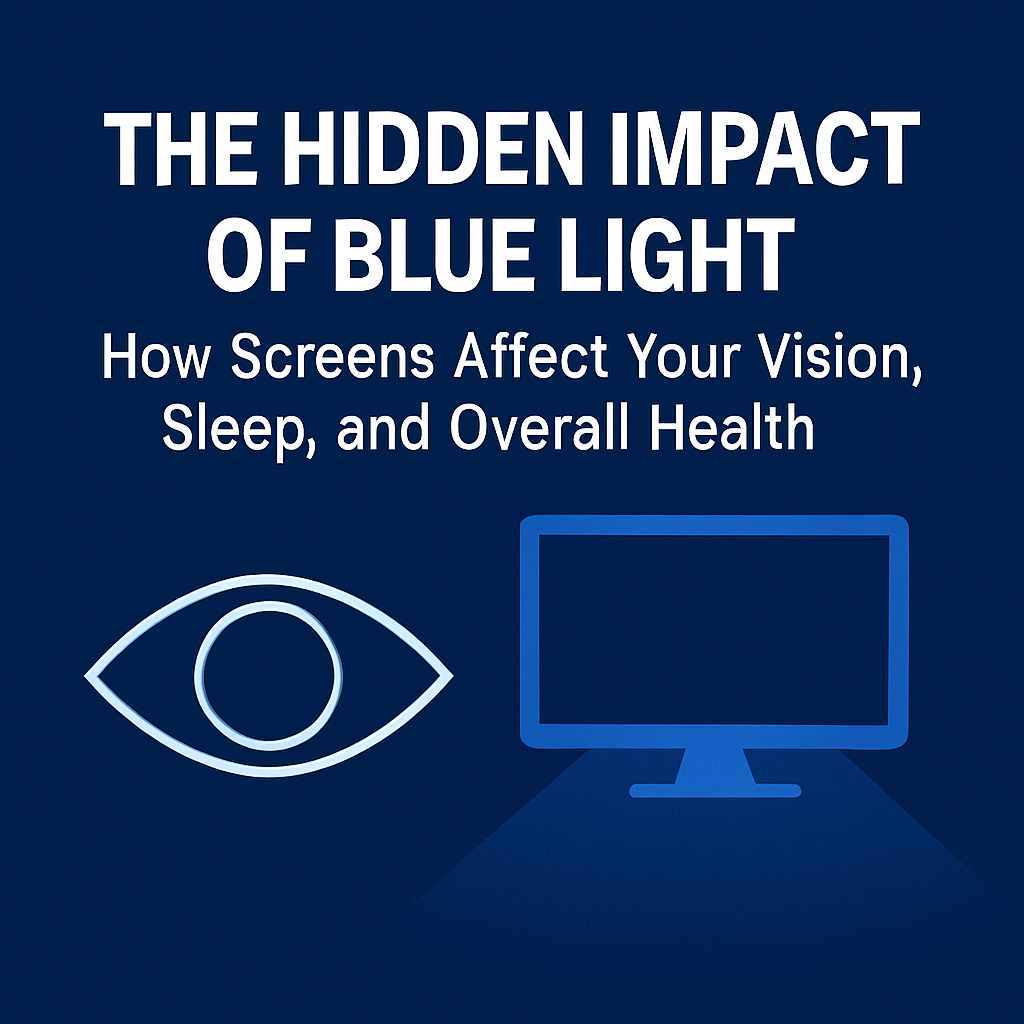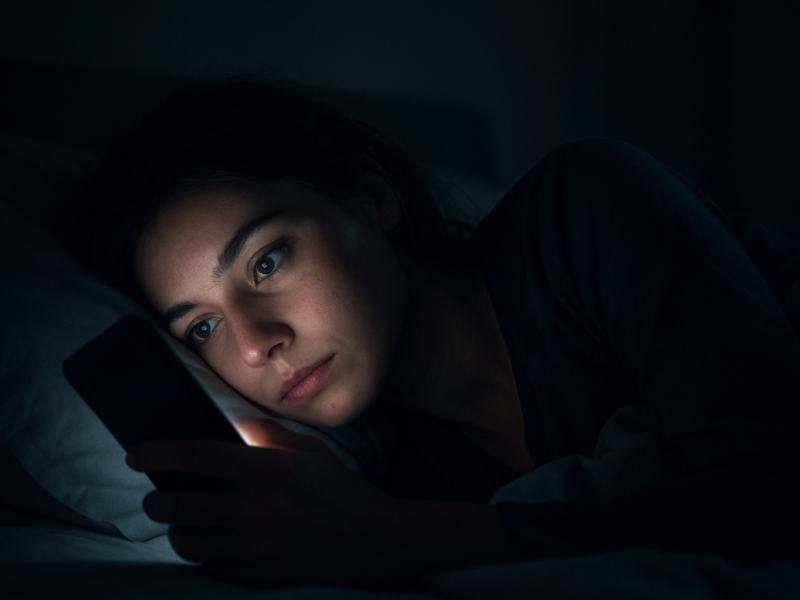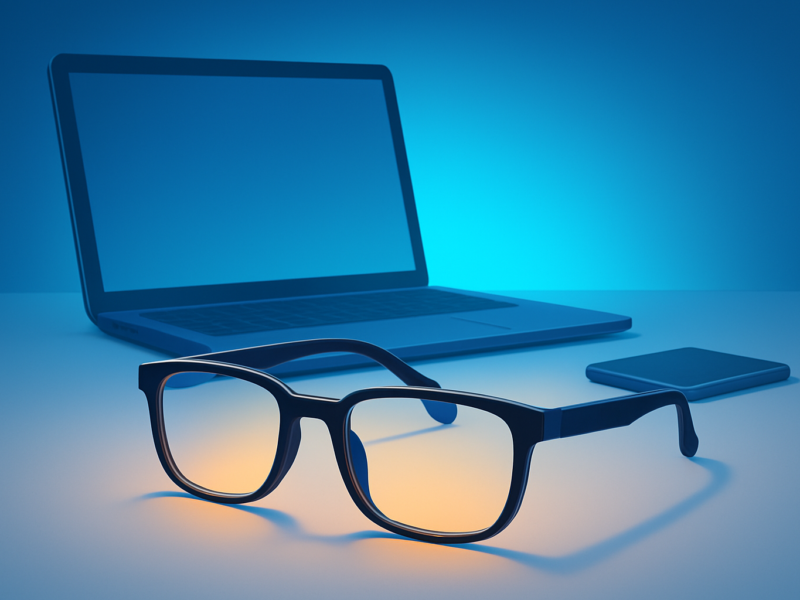Introduction
We live in an era where screens dominate every part of our lives. From early morning scrolls on smartphones to late-night Netflix binges, digital screens have become an unavoidable companion. Along with their convenience, however, comes growing concern about blue light exposure and its potential effects on vision, sleep, and overall health.
But what exactly is blue light? Is it truly harmful? And more importantly, what can you do to protect yourself without cutting screens out of your life completely?
This article explores the science, myths, and protective strategies around blue light exposure — giving you the tools you need for healthier eyes and better digital wellness.
What is Blue Light?
Blue light is a high-energy visible (HEV) light in the 380–500 nanometer range of the spectrum. Unlike other colors of visible light, blue light penetrates deeper into the eye, reaching the retina.
There are two main sources:
- Natural Blue Light: Comes from the sun and plays an essential role in regulating circadian rhythm, mood, and alertness.
- Artificial Blue Light: Emitted by digital devices like smartphones, laptops, tablets, LED screens, and modern lighting.
While natural blue light is beneficial during the day, overexposure to artificial blue light, especially in the evening, can cause health and vision issues.
The Impact of Blue Light on Eye Health
1. Digital Eye Strain
One of the most immediate effects of blue light is digital eye strain, also known as Computer Vision Syndrome. Symptoms include:
- Dry eyes
- Headaches
- Blurred vision
- Eye fatigue
Prolonged screen use forces the eyes to constantly refocus and adjust, leading to discomfort and strain.
2. Sleep Disruption
Blue light significantly affects melatonin production — the hormone responsible for regulating sleep. Exposure to screens before bedtime sends signals to your brain that it’s still daytime, delaying sleep onset and reducing sleep quality.
This can lead to:
- Insomnia
- Poor sleep cycles
- Reduced REM sleep
- Increased daytime fatigue
3. Long-Term Vision Risks
Although research is ongoing, some studies suggest that long-term exposure to blue light could contribute to retinal stress and may increase the risk of macular degeneration over time.
Even though the evidence isn’t conclusive, the potential risks make preventive measures worthwhile.
Myths vs. Facts About Blue Light
- ❌ Myth: Blue light exposure from screens causes blindness.
✅ Fact: Normal screen exposure hasn’t been proven to cause blindness, but it may contribute to eye strain and discomfort. - ❌ Myth: Blue light glasses completely eliminate risk.
✅ Fact: Glasses help reduce strain, but lifestyle habits and screen hygiene are equally important. - ❌ Myth: Only office workers are at risk.
✅ Fact: Children, students, gamers, and seniors are just as vulnerable.
Strategies to Protect Yourself from Blue Light
1. Adjust Your Devices
- Use Night Shift (iOS), Night Light (Windows), or apps like f.lux.
- Reduce brightness and increase text size.
- Enable “dark mode” where possible.
2. Blue Light Glasses
These specially coated lenses filter out a portion of harmful blue light. While they’re not a magic solution, they can reduce strain during long hours of screen time.
3. Screen Filters
Physical filters for monitors, laptops, and smartphones provide an added layer of protection, blocking up to 50% of HEV light.
4. Optimize Lighting
Avoid working in dark rooms with bright screens. Instead, maintain balanced ambient lighting to reduce eye strain.
5. Practice the 20-20-20 Rule
Every 20 minutes, look at something 20 feet away for at least 20 seconds. This relaxes the eye muscles and reduces strain.
6. Lifestyle & Nutrition
Certain nutrients support long-term eye health and resilience against blue light damage:
- Lutein & Zeaxanthin – found in leafy greens
- Omega-3 fatty acids – from fish and flaxseed
- Vitamin A & C – for retinal protection
7. Digital Detox
Schedule regular breaks away from screens. Screen-free meals, evening walks, and device curfews before bedtime all help restore balance.
Special Considerations for Different Groups
Children & Teens
- More sensitive to blue light
- Excessive exposure can lead to learning difficulties, fatigue, and poor sleep
- Recommendation: Parental screen-time limits and protective eyewear
Office Workers & Remote Employees
- 8–12 hours of daily screen exposure
- Risk of chronic digital eye strain
- Recommendation: Ergonomic setup + blue light filters
Gamers & Content Creators
- Extended, intense exposure
- Late-night gaming worsens sleep cycle disruption
- Recommendation: Glasses + screen filters + strict cut-off times
Seniors
- Pre-existing conditions like cataracts and macular degeneration make them more vulnerable
- Recommendation: Regular eye exams + protective measures
Future of Blue Light Protection
Technology continues to evolve:
- OLED and e-ink screens – emit less blue light than traditional LED screens.
- Low blue light monitors – now common in professional workplaces.
- Smart glasses – may integrate AI to dynamically filter harmful light.
Research is ongoing to separate fact from myth, but one thing is clear: screen habits will define the future of eye health.
Conclusion
Blue light is not inherently harmful — in fact, it’s essential for alertness and daily rhythm. However, overexposure from artificial screens, particularly at night, poses risks to vision, sleep, and overall well-being.
By combining protective tools like glasses and filters with healthy digital habits, you can enjoy technology while safeguarding your vision for the future.
👉 Your eyes are priceless — protect them today for a healthier tomorrow.


